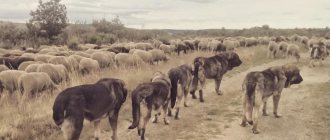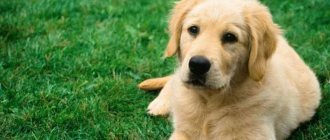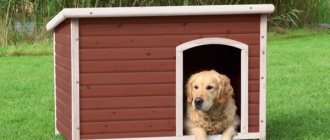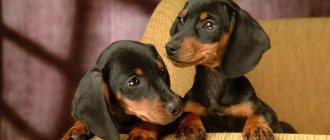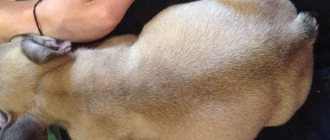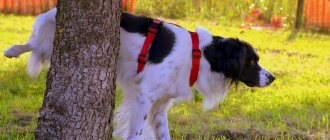Labradors are a popular dog breed: smart and good-natured retrievers make excellent companions, loyal and sincerely loving pets. These magnificent animals are great for both couples with several children and single elderly people.
Before you bring home a shaggy, life-loving Labrador, you should carefully familiarize yourself with the standard characteristics, a set of specific, precisely established dimensions of the dog. Such parameters of a Labrador Retriever as weight, height and other overall dimensions are the most important factors necessary for monitoring conditions, organizing exhibition activities and solving everyday details of the life support of a toothy pet.
Getting to know the famous retriever branch begins with studying the breed's reference registry.
How much should an adult pet weigh?
Labradors grow up to a year, after which they practically do not change. Owners only need to worry about maintaining shape.
Labradors are prone to weight gain, and their diet and physical activity must be strictly controlled . Obese dogs experience heart problems.
Labrador boys weigh differently than girls.
For males, the norm is a weight of 28-36 kilograms; for females, a weight from 25 to 33 kilograms is considered normal..
How much does an adult dog weigh?
Labrador is a large breed of dog. The sizes depend on the sex of the individual; girls look slightly smaller than boys. Optimal performance for an adult dog:
- height – 0.56-0.63 m (for a male) and 0.54-0.6 (for a female);
- weight – 27-40 kg (for a male) and 27-35 kg (for a female).
During canine shows, experts take measurements of dogs and compare them with standard indicators. The breed has 3 recognized standards: international, English and American. British and world standards are almost identical. They allow deviations from growth parameters of up to 1 cm. The American template is more flexible. According to it, the height of the animal at the withers may differ by 3-5 cm.
Body weight is not so strictly regulated. However, the general proportions (the ratio of height at the withers and weight) must be maintained. As a rule, an adult Labrador weighs around 30 kg. Excess weight affects your pet's health. Owners must properly balance the daily diet of the ward, and also pay attention to physical activity during walks.
When a Labrador puppy appears in the house, the owners have many questions: is it developing correctly, what is the optimal weight gain, how much does an adult Labrador weigh and many others. To answer them, you should study the growth and development rates of the puppy.
Health control
Systemic measurements are also relevant for non-show activity: a table of labrador retriever weight gain by month is an excellent tool for monitoring the health of labrador fry. The table showing the growth of a Labrador by month is an indicator of proper development.
Excess fat mass is a common occurrence in Labradors. Cheerful life-lovers are famous for their insatiable appetite and absolute omnivorousness. Obesity is a painful form that requires tough decisions and immediate action: excess weight is harmful to health and shortens a pet’s life expectancy. To diagnose obesity, it is enough to compare the reference age indicators and the results of weighing a toothy pet. If your Labrador’s weight per year exceeds the declared norm by more than fifteen percent, it’s time to urgently contact a veterinarian and nutritionist.
Excess weight that develops into obesity is a serious problem and a source of serious complications. Loss of physical activity creates a “vicious circle”: the dog needs to actively move in order to “throw off” those extra pounds, but the dog cannot do this due to health conditions.
Chocolate Labrador
There are fewer of these dogs, so a small purebred chocolate-colored puppy will cost much more. There are several acceptable shades for chocolate Labradors:
- light chocolate;
- hepatic;
- bitter chocolate.
Related article: Can a Labrador live in an outdoor enclosure in winter?
The coat must be a single color and the standard excludes the presence of any spots or even hairs of a different color (although a light patch on the chest is still allowed). Therefore, be very careful when choosing a chocolate-colored dog - there are many unscrupulous breeders, and they may well profit from your ignorance. The dog's eyes should be brown, although it is acceptable if there is a yellowish tint.
We recommend this article:
Weight of a puppy and an adult Labrador by month
Dimensions (height at withers, etc.) for an adult Labrador, depending on gender
There is an American standard, according to which the height of females is up to 55 centimeters at the withers, males - up to 57 centimeters.
You can measure your dog at home. The breed standards, in addition to general height and weight, include indicators of head length, cheekbone width, length of the body and front legs, chest girth, wrist girth, muzzle length, distance between the shoulder blades, and leg length.
The Labrador is considered a dog of medium height - not very tall and not too small - and quite large in build.
requirements :
- Wedge-shaped large head.
- Powerful muzzle with large nostrils.
- Strong rounded jaws.
- Straight and level nose.
- The eyes are not very big.
- The tail is moderately long, straight, wider at the base and narrower towards the end.
- The hind legs are more developed than the front legs.
Expert opinion
Tolkachev Andrey Mikhailovich
veterinarian
If a Labrador's weight exceeds the norm (you can check the size chart and try on the dog yourself at home; on average, an adult dog is about thirty kilograms and half a meter in height), then this cannot be ignored. These dogs have a high appetite, they do not know how to control themselves, and apartment pets most often suffer from obesity. Closer to the age of 10, Labradors become overgrown with fat deposits, this can be avoided if the dog is loaded with physical exercise - running, long walks, swimming - one and a half to two active hours a day. You can check for excess weight by lightly pressing the ribs with your fingers: they should be palpable, but individual ribs should not be visible. If a Labrador does not grow more than forty centimeters for a long time - for example, up to a year - then it is too early to panic, perhaps the dog has not yet matured: adult individuals sometimes grow up to one and a half years.
Unusual colors
In addition to those described above, there are species with unusual colors. These include Dudley, spotted and silver Labradors. The main difference between Dudley and the standard is the pinkish tip of the nose and light pigmentation of the gums and eyelids. Golden dudleys are most common, but they also come in black and cream. The eyes of these animals may even be green, which is unacceptable for the standard.
Spotted dogs are also considered an unacceptable deviation from the standard, although they look quite cute. But the silver Labrador, which is not included in the breed standard, is quite popular at the moment. Although it will not be possible to participate in exhibitions with him, many people want to buy a dog of this particular color. And demand, as you know, creates supply, so silver dogs can be purchased at a very high price. Although you will not be able to participate in dog shows with a pet of non-standard colors, this does not mean that such a dog will not become a loyal friend and family member. In addition, by purchasing an animal of an unusual color, you will spend much less money.
Similar article: First heat and rules for mating Labradors
Breed standard
There are 3 types of standards for the Labrador breed. The most common is the international standard FCI (Fédération Cynologique Internationale). The English standard is almost entirely FCI compliant. The American standard allows for errors in growth rates of 3-5 cm.
Exterior
The dog is large and strong. The body does not look overweight or stretched. Proportional addition. The dog is mobile, the muscles are clearly visible. Wide chest and forehead. Strong hindquarters.
Labrador retriever males are larger and more courageous than females and have a massive head. Bitches look more graceful, lighter built, the pelvis is larger than the head.
For males, the ideal height at the withers is 56-57 cm with a weight of 28-36 kg. For females, height ranges from 54-56cm, weight – 24-32kg. Deviations in height are allowed within 1 cm.
Weight indicators are not strictly regulated and are recommendations, however, you should pay attention to the consistency of the dog’s appearance and weight. Excess weight may indicate obesity; underweight may indicate poor nutrition or illness.
Head
Pronounced and large. The length of the muzzle corresponds to the length of the head. The line of the nose is almost parallel to the line of the skull, with a pronounced transition to the facial part. Sometimes there is a characteristic bump on the back of the head. The skin is tight, without sagging. The arrangement of teeth is linear. A straight bite is considered acceptable. The incisors are long, but not pointed.
The eyes are set deep in the sockets. Lively, expressing intelligence and interest. Eye color is predominantly brown.
The ears are hanging, but not heavy, triangular in shape. They fit tightly to the cheeks, but lag behind during movement.
Frame
The neck is well defined and of medium length. Provides high mobility. Without sagging or bulging, it has a pronounced scruff. The back is straight, without humps or sagging. The croup is wide and short. The chest extends beyond the line of the paws when viewed from the front. The ribs are well sprung. The stomach is tucked up, not drooping.
Limbs
The forelimbs are level, stand at right angles to the ground and are located exactly under the body. A characteristic feature: the shoulder blade forms a right angle with the shoulder, and the length of the shoulder blade is equal to the length of the shoulder.
The hind limbs are powerful. The lower leg is slightly elongated. The hock joints are set low. The croup is straight without slope. The paws are round, compactly gathered into a ball. The pads of the dads are spaced well enough to distribute the load when walking.
The tail tapers towards the end from a thick base, so its appearance resembles that of an otter. The fur on the tail is rough. In a calm state, the tail droops; when excited, it rises to the level of the back.
Coat and color
The coat is short and uniform, without bald spots. The undercoat is oily and water-repellent.
Colors: pure black, chocolate (liver) brown, cream, chestnut, yellow. A light star on the chest is allowed.
Character
The character is soft and obedient, active and playful. Loves to swim. Labrador is good-natured towards adults, children, and other dogs. Has good instincts and loves to hunt. Very efficient. Strives to please the owner.
According to dog attack statistics in America from 1982 to 2014, the Labrador ranks 9th out of 73 dogs. Despite the fact that the dog is not at all aggressive, it still requires attention and training.
The most common Labrador breed inconsistencies that you need to pay attention to when choosing and raising a dog:
- Males are similar to females.
- Aggressive or timid character.
- Long or short legs.
- Elongated or shortened body.
- White or colored spots, uneven color.
- Small head, short or narrow muzzle, uneven nose line.
- Semi-erect ears.
- Slanty eyes.
- Caries.
- Long neck.
- Narrow withers, pointed shoulder blades.
- Sagging back.
- Short or long tail.
- Narrow chest.
- Sagging belly.
- Small distance between fore and hind legs.
- Clubfoot.
- Heavyness, swaying of the croup vertically when walking.
The nominal weight of an adult Labrador (male) is 30 to 40 kg. Knots weigh 25-32 kg. As a result of poor nutrition, Labradors can gain weight faster, which can lead to heart disease.
The height of males at the withers is 56-58 cm, females approximately 54-56 cm.
We invite you to read: How much does a cat weigh: table of cat weight by age, norm and reasons for deviation from it
Head circumference – 46-56 cm.
Bust circumference – 70-86 cm.
Muzzle length – 7.5-10 cm.
Muzzle circumference – 28-32 cm.
The girth of the mouth is 11-14 cm.
table on how to identify and choose
Before choosing outfits for your pet, you need to know how to determine dog clothing sizes. Basic moments:
- focus on the length of the back from the base of the neck to the beginning of the tail;
- It is recommended to measure chest circumference just behind the front legs at the widest point of the chest;
- neck volume is often equated to collar circumference;
- The dog must stand level on all fours during measurements.
Compare the measurements obtained with the indicators in the size table. In a situation where the parameters are between two parameters, you should round up.
You can choose the right shoes by measuring your foot. To do this, place your pet on a piece of paper and mark the distance from the claws to the heel. The easiest way is to draw an outline and measure its length and width.
Limargy clothing size chart
| Size | Neck circumference (cm) | Back Length(cm) | Chest (cm) | Dog breeds |
| XS | 18-20 | 17-20 | 28-32 | Chihuahua, toy terrier, mini Yorkie, small breed puppies |
| S | 20-24 | 22-25 | 36-40 | Yorkshire Terrier, Toy Terrier, Maltese, Japanese Chin, Pomeranian Spitz |
| M | 24-27 | 26-29 | 40-44 | Chinese Crested, Pug, Toy Poodle, Large Yorkie, Shih Tzu, Miniature Pinscher |
| M.L. | 27-29 | 29-31 | 44-47 | Chinese Crested, Pug, Toy Poodle, Large Yorkie, Shih Tzu, Miniature Pinscher |
| L | 28-32 | 31-34 | 46-50 | Miniature poodle, shih tzu, fox |
| XL | 31-38 | 36-39 | 54-58 | Cocker spaniel, poodle |
Limargy shoe size chart
Clothing size chart ForMyDogs
4dog.su
Puppy weight and sizes from 1 to 12 months
The weight of newborn Labradors ranges from 40 to 55 grams . Every day they increase to 120 g. From birth to the first month, puppies grow up to 23 centimeters, at three months they reach 40 centimeters, and by six months - 50 centimeters.
Meeting height and weight standards is necessary because this indicates the health of the puppy, as well as its purebred.
At exhibitions where Labradors are examined by experts, the first thing that is done is weighing and other essential measurements.
Therefore, the owner’s responsibility is not only to raise the pet, but also to monitor how it grows in size, strictly following the required diet.
| Age | Weight, kg | Height at withers, cm | Chest girth, cm. |
| 1 month | 3,5-3,8 | 23-23,5 | 37-38 |
| 2 months | 7-8 | 30-32,5 | 45-46 |
| 3 months | 12-14 | 39,5-42 | 51-56 |
| 4 months | 17-19 | 44-46 | 60-64 |
| 5 months | 21-22 | 48-51 | 66-68 |
| 6 months | 24-26 | 50-55 | 67-70 |
| 7 months | 26-28 | 52-56 | 69-74 |
| 8 months | 28-30 | 54-57 | 70-76 |
| 9 months | 30-32 | 55-59 | 70-77 |
| 10 months | 30-36 | 55-59 | 70-84 |
Puppy weight by month
Let's start with how much a healthy dog should weigh. Since the main characteristics are weight and height, we will also talk about what height is considered normal for babies. A special table will help us figure out the size of the puppy.
| Age (months) | Weight, kg) | Height (cm) |
| 1 | 3,4 – 3,8 | 23–23,5 |
| 2 | 7–8 | 30–32,5 |
| 3 | 12–14 | 39,5–42 |
| 4 | 17–19 | 44–46 |
| 5 | 21–22 | 48–51 |
| 6 | 24–26 | 50–55 |
| 7 | 26–28 | 52–56 |
| 8 | 28–30 | 54–57 |
| 9 | 29–32 | 54–58 |
| 10 | 30–36 | 54–58 |
A healthy Labrador puppy's weight increases by at least 2 kg every month. And if we summarize the entire table, then the dog’s weight should increase 10 times on average in 10 months. The growth of a Labrador also varies from month to month and is finally formed by the year.
In order to monitor the parameters of a Labrador Retriever, you need to measure it at the withers. To do this, you will need, firstly, a centimeter, and secondly, the dog’s good disposition. The baby should not be hungry, and let there be a minimum of irritants around. The retriever grows up to almost a year, so significant changes occur every 30 days. For this reason, measurements are taken on a Labrador show puppy monthly, as it must meet standards in order to take part in shows.
As can be seen from the table, active weight gain occurs as early as 2 months - the weight increases almost 2 times. Already at 3 months, the puppy begins to gain an average of 3 kg in 30 days of life, but by 5 months the baby should already have two-thirds of the required weight. At 4 months, the dog’s growth at the withers also slows down. But at 6 months, a maximum of 8 cm should be missing from the norm. On the one hand, if you observe your four-legged friend monthly, then not such big changes occur to him: his weight increases by two kilograms, and his height increases by a couple of centimeters. One way or another, the puppy must follow the required parameters upon reaching a certain age, otherwise the path to exhibition events will be closed to him.
Related article: How long do Labradors live at home?
To ensure that the pet does not deviate from the norm, the owner must provide it with proper care, a balanced diet and sufficient exercise. Excess pounds are just as dangerous as being underweight. Be attentive to your baby, because he is entirely dependent on you.
Compliance with the parameters is not only a sign of elitism, but also of health.
We recommend this article:
How to care for a puppy and an adult Labrador
Features of feeding and diet
Nutrition for puppies is important in principle, but for Labradors, who love to eat, it is doubly important. Newborns feed only on mother's milk, but here, too, a certain schedule must be followed:
- 12 times a day for the first week;
- 8 - in the second;
- on the third - 6.
The owner’s task in this case is to ensure that the female feeds the babies in a timely manner. But somewhere around 3-4 weeks the baby may not have enough maternal nutrition, so it is important to know what to feed your Labrador puppy during this period.
Natural nutrition
Natural products can be used as complementary foods for a growing body: the basis (50-60%) should be meat, a little less (30%) cereals and 10-20% vegetables. Boiled eggs, boiled sea fish, offal, cottage cheese or kefir will also fit perfectly into the menu. You should definitely avoid the following foods in your Labrador's diet:
- sweets;
- pickles;
- milk;
- fatty meats;
- potatoes, cabbage, onions.
Food for a puppy should not be cold or hot, salt and spices should not be added to it. It is advisable to introduce foods gradually, one at a time, monitoring the growing body’s reaction to complementary foods. Important! Labradors are easy to overfeed because they love to eat, but overfeeding in their case can lead to obesity. Therefore, it is recommended to remove leftover food immediately after feeding, rather than leaving it for the baby.
Dry food
Dry food can be given to babies starting from the sixth week, when baby teeth appear. To begin with, give one granule, then the next day a couple and so on, so that the addiction is gradual.
There are several points that play an important role in feeding with dry food:
- choose only high-quality brands that avoid the use of harmful substances in the composition;
- It is advisable not to change the chosen brand in the future, this may cause stomach upset in the baby;
- It is necessary to feed the puppy dry food 5-6 times a day;
- It is advisable to create a feeding schedule and stick to it day after day.
Dry food is an excellent option for babies, because their balanced composition contains all the necessary additives and microelements for the harmonious growth and development of a Labrador.
How to measure height correctly?
You need to use several tools: a centimeter, a ruler, a tape, a square. The height of a dog can be determined by extending a centimeter (tape) along the animal’s body: the end is applied to the floor and extended to the withers.
Height is the distance from the dog's foot to the withers.
Metric information is collected from a standing dog. The animal must be in good spirits and not hungry. The best way to measure a Labrador is at home, in a calm environment; you can cheer him up with a treat.
Gradually the dog will get used to such manipulations and will respond well to them.
The height at the sacrum can be measured with a centimeter (tape, ruler) - from the floor to the highest point of the croup, in maclocs.
To make accurate measurements, the instruments must be placed at the correct points so that they fit against the animal's body, but do not press in. If the hair is long, then to accurately measure growth you need to part the hair and apply a centimeter (ruler, tape) to the skin.
To measure body length, first apply the end of the centimeter to the shoulder, then to the ischial tuberosity. When comparing actual sizes and standards, a special index is used, that is, an indicator of one dog parameter to another.
Growth in this case is the main factor; other results are correlated with it. For example, they distinguish the elongation index (body length to height) and boneiness (carpal girth to height).
IMPORTANT!
Indices allow you to judge whether a four-legged pet meets breed standards.
All data in breed tables are approximate . Sometimes puppies are already fully formed by the age of six months, and often continue to grow after a year.
If the height of a real dog does not coincide with the ideal parameters from the table, then there is nothing to worry about . The totality of all measurements, the general constitution of the dog’s body, is looked at.
This helps to monitor how your pet is developing. It is the height-weight ratio that gives experts an idea of how well developed the dog is, whether its ancestors were purebred Labradors or whether there was a crossbreed during mating.
At exhibitions, any measurements of an animal are allowed only in the presence of the owner . Service dog breeding usually operates with the indices of elongation and boneiness.
Brief history of formation
Much of its history remains a mystery; different sources offer numerous versions of its origin. One is definitely a dwarf Labrador - it came from an aboriginal dog - the Newfoundler, which was widely used to help fishermen. The dog pulled nets out of the water, could pick up fish, and actively participated in hunting small game.
- The Europeans, who had their eye on the bright dog, happily took several puppies for themselves, after which they immediately gained popularity.
The peculiarity of a non-conflict nature and diligence allowed the breed to be used as guide dogs. A kind character and acceptable appearance, the ability to interact with people, helped to gain a foothold in society, both among wealthy people and ordinary hard-working people.
The first Labrador standard officially registered with the Canine Federation was adopted in 1905. The breed is named after the peninsula of the same name.
Today, representatives are widespread throughout the world, and work is still underway to improve their breeding appearance and character.
Species in Labradors
Labrador is a retriever and the description of the Labrador breed does not provide for any varieties in size and characteristic differences in exterior.
The only differences between representatives may be in color and its saturation. All sizes of the animal are clearly stated in the standard descriptions; there is no talk of any varieties.
Types in Labradors are divided into basic differences in color and coat, as well as some characteristic differences in the animal's personality.
- Golden ones are calmer;
- Straight-haired - may be more wary and lazy;
- Curly hair is the best guard for a home;
- The Nova Scotian is an ideal guard, but is less predisposed to training;
- Black is more obedient.
These descriptions are not directly related to the standard, the information only conveys the characteristics of behavior, but all descriptions are more common between owners. Officially, the first dog was a black Labrador, which was the only one for a long time, after which breeding of other colors was allowed.
To what age do they grow?
There are three stages of maturation and growth of a Labrador puppy:
- The first four months are a pronounced growth.
- From five to eight months – a slowdown in growth rates.
- From nine months to one year – a slight increase in height and weight.
It is believed that from the age of one year dogs can already take part in exhibitions, their body is fully formed. There are three breed standards: international, British and American.
World and English are very close to each other, these are strict standards . They allow deviations from the reference height of up to one centimeter.
The American allows the dog to be three to five centimeters below or above the standard.
The weight of Labradors is not so clearly regulated, the main thing is the ratio of weight and height.
Puppy weight and height by month
During the first year of life, a tiny retriever puppy goes through the process of maturation. There are three stages:
- up to 4 months – rapid growth;
- 5-8 months - slow development;
- 9-12 months – slight increase.
After the expiration of the period, the adult dog is already suitable for participation in exhibitions.
It is extremely important that the general parameters - height and weight - meet the requirements of the officially approved standard. Deviations upward or downward are considered unacceptable and the individual is rejected.
Dogs are born weighing from 0.4 to 0.55 kg. Every day they gain 120 g in weight. During the first week of life, the baby gains about 1 kg. According to generally accepted standards, a baby Labrador grows rapidly in the first two months after birth. Its mass increases almost 2 times.
A month old Labrador reaches 3 kg and stretches approximately 23 cm in height. At 5 months of age, according to the rules, a puppy must have 2/3 of its standard weight. After 10 months, the dog’s parameters practically do not change. The one-year-old black retriever is fully grown.
To compare the indicators, special tables are used that show the height and weight of Labrador puppies on a monthly basis. However, in real life, the size of a pet may differ from the average. Each individual develops under the influence of many factors. Among them:
- diet;
- physical exercise;
- Lifestyle.
Table of Labrador development parameters (by month):
First vaccinations
At the age of 1 month, the puppy needs to be dewormed.
The first comprehensive vaccine for dogs against distemper, infectious hepatitis, parvovirus enteritis, parainfluenza and leptospirosis is given 10 days after deworming. After 14 days, a second comprehensive vaccination is given, at this stage vaccination against rabies is also carried out. Quarantine lasts 10-14 days after the second vaccination, revaccination - once a year.
Puppies are vaccinated according to the schedule from the vaccine manufacturer. Veterinary clinics offer vaccines from domestic and imported manufacturers, for example, Biovac, Multikan, Nobivak, Vanguard, Duramun, Eurikan.
What affects a puppy’s parameters?
The future weight and height of the puppy is influenced first by uterine development, and then by the suckling stage . Did the mother receive good care during pregnancy, were there vitamins in her diet, were any pathologies detected in the embryos - all these factors already lay the foundation for the development of the puppy.
From birth, boys are larger than girls . If a male dog is smaller than his sisters, this indicates incorrect development; such a puppy needs to be fattened and checked for infections and other abnormalities.
If the litter is small, the puppies will be larger than in litters where many are born. If puppies are given early and correct artificial feeding, they will grow faster and gain significant weight, possibly becoming fat.
Factors that influence a dog's development include::
- Nutrition;
- Activity and physical activity;
- Lifestyle in general.
The basis for the correct development of a puppy (weight and height ratio) is the diet and living conditions. These are the fundamental factors before the age of eight months.
The younger the dog, the faster it grows, the more important it is to monitor its nutrition and give it a complete diet with vitamins . The animal should be cleaned of parasites and bone development should be monitored.
If the bones are poorly developed before six months (puppies can develop rickets or osteochondrosis due to improper nutrition and exercise), then it is unlikely that it will be possible to correct this later.
Puppies grow unevenly . At a certain period, certain parts of the body grow: short legs and a long body, elongated legs and a narrow chest, first - development in height, then in width.
This is normal, the Labrador will acquire the correct proportions by the age of one year. For example, dogs' ears are formed first; there is no need to be afraid that they are very large.
If the puppy is not gaining weight, you need to check it for helminths (worms).
Which color to choose
As stated earlier, this is a matter of personal preference, but there are several factors you can consider when choosing. Remember that dogs love “mud baths.” They love to roll around in the dirt, so most of the time your pet will be spotted instead of light colored. For this reason, some people prefer to have dogs with black fur. However, you will have to wash your pet in any case - no matter how clearly it is visible that he is smeared in dirt.
Also keep in mind that individuals with brown fur can fade in the sun, and due to the activity of the animal, it will not be possible to keep it in the shade. Therefore, in the hot season, the pet’s color may be uneven. Of course, with the onset of cold weather, the color will return to normal, so there is no need to worry about this.
If you want your pet to look menacing and impressive, choose a black dog.
They have a rather dangerous appearance, so you are unlikely to encounter bullies if such a defender is nearby. There is also an opinion that dogs with dark hair are much more difficult to photograph than light ones. So if you are going to show off your pet to the whole world, choose more photogenic, light-colored dogs.
Related article: How to care for a puppy and an adult Labrador
In general, all these factors are insignificant. Whatever color the dog is, it will make a great friend. You just need to give her your love and care, and she will definitely reciprocate.
We recommend this article:
How to choose a nickname for a Labrador boy and girl
Interesting facts about Labradors
- Labrador dogs have a high pain threshold, so without hesitation they rush into the epicenter of misfortune to save people. Thanks to this feature of the breed and their good sense of smell, Labrador retrievers often become assistants to the police and the Ministry of Emergency Situations.
- Labradors are waterfowl dogs: they have water-repellent fur, webbed paws and a tail that acts as a rudder.
- Labradors are used for canistherapy in cancer centers, hospitals for the mentally ill and to treat children with psychological problems.
What to do if your weight is below normal
Monitoring your puppy's development means weighing him periodically. If the dog does not gain weight for a significant period of time, it needs to be dewormed. Then introduce nutrition and vitamins into the diet.
If in this case the puppy remains small, then you need to contact a veterinarian.
NOTE!
There may be health problems: lethargy, reluctance to eat, very poor appetite are the first signs of this.
A dog can also lose weight due to a violation of mineral metabolism. This is typical for puppies and teenagers.
